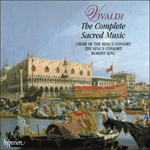
Welcome to Hyperion Records, a British classical label devoted to presenting high-quality recordings of music of all styles and from all periods from the twelfth century to the twenty-first.
Hyperion offers both CDs, and downloads in a number of formats. The site is also available in several languages.
Please use the dropdown buttons to set your preferred options, or use the checkbox to accept the defaults.

It is not known for what occasion or institution this exceptionally brilliant and vocally taxing motet was written. One thing is virtually certain: it was not composed for the Pietà. While this might suggest that the intended singer was more probably a male castrato, it is important not to view high vocal parts of the time as gender-specific. Vivaldi did indeed tend to customize his motets, but always tailored them to an individual singer, not to a gender (over the choice of which composers and audiences tended to be very pragmatic).
from notes by Michael Talbot © 1996
Nous ignorons pour quelle occasion ou institution ce motet exceptionnellement brillant et vocalement ardu fut composé, mais nous sommes presque sûrs qu’il ne fut pas écrit pour la Pietà. Il est important de ne pas considérer les parties de dessus de cette époque comme sexuellement spécifiques. Certes, elles étaient souvent personnalisées, mais toujours façonnées pour un interprète particulier, sans se préoccuper de son sexe (sur le choix duquel les compositeurs et le public tendaient à être très pragmatiques).
extrait des notes rédigées par Michael Talbot © 1996
Français: Hyperion Records Ltd
Der Anlaß oder Auftraggeber für das Komponieren einer so ausnahmslos brillanten und vokal sehr anspruchsvollen Motette ist unbekannt. Eines ist jedoch gewiß: Sie wurde nicht für die Pietà komponiert. Es ist wichtig zu bemerken, daß die höher liegenden Passagen damals nicht als geschlechtsspezifisch aufgefaßt wurden. Wahr ist, daß ihre Anwendung häufig war—sie wurden aber auch immer bestimmten Sängern und nicht dem Geschlecht angepaßt (sowohl die Komponisten als auch das Publikum tendierten dazu, dieser Wahl recht pragmatisch zu begegnen).
aus dem Begleittext von Michael Talbot © 1996
Deutsch: Ute Mansfeldt
 Vivaldi: The Complete Sacred Music Vivaldi: The Complete Sacred Music‘For King's sterling service to the Vivaldian cause, one of his most important recording and satisfying projects to date, I am thankful’ (Gramophone) ‘If you're waiting for the perfect collection of Vivaldi's sacred music, this is it. It was a happy day when this beautiful boxed set arrived in my m ...» More |

